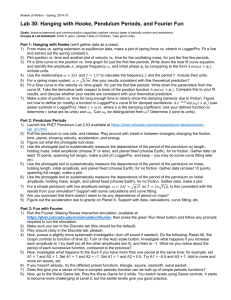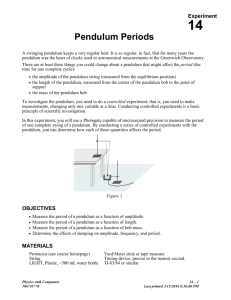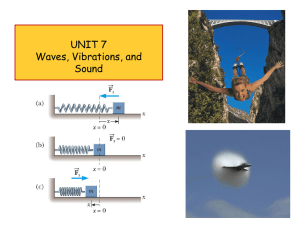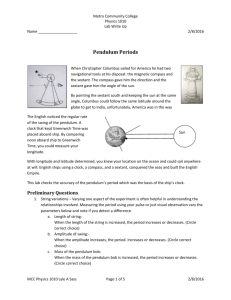Lesson 1 * oscillating systems
advertisement
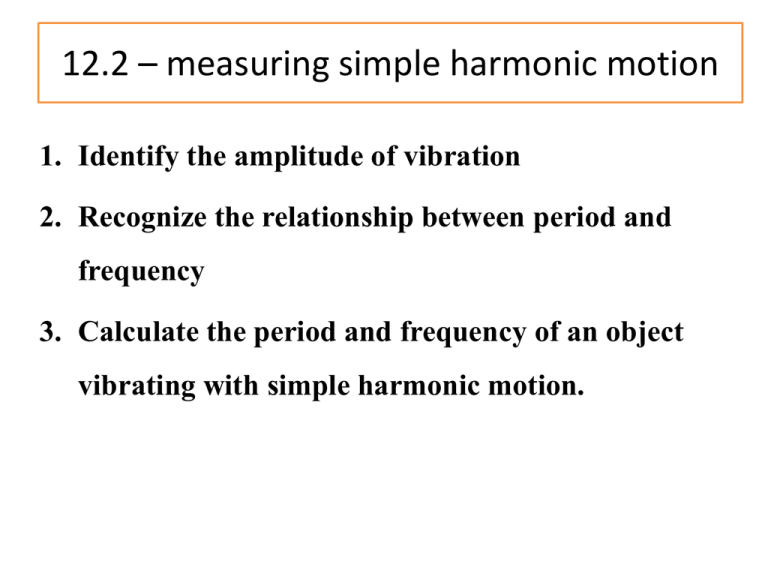
12.2 – measuring simple harmonic motion 1. Identify the amplitude of vibration 2. Recognize the relationship between period and frequency 3. Calculate the period and frequency of an object vibrating with simple harmonic motion. Properties of SHM • The object is moving over the SAME PATH over the course of time. • The time it takes to complete one back and forth cycle is always the SAME TIME. • In Physics, a motion that is regular and repeating is referred to as a PERIODIC MOTION. Amplitude, period and frequency • AMPLITUDE (A): the maximum displacement from equilibrium. It is a reflection of ENERGY possessed by the vibrating object. The SI unit of A is m, cm, … • PERIOD (T): the TIME it takes to execute ONE COMPLETE CYCLE of motion. The SI unit of T is second. • FREQUENCY (f): the NUMBER OF CYCLES or vibrations PER UNIT OF TIME. The SI unit of f is Hertz or (1/s) Amplitude of Vibration Period and Frequency • If we collect the data on position and time of mass on a spring and graph position vs. time, the graph might look like this: Period (T) is 0.05 s (time of one complete cycle) Frequency (f) describes number of cycles per unit of time: f = 2/0.10s = 20 Hz. frequency and period are inversely related to each other T 1 f Example #1 • A pendulum is observed to complete 23 full cycles in 58 seconds. Determine the period and the frequency of the pendulum. Example #2 • A mass is tied to a spring and begins vibrating periodically. The distance between its highest and its lowest position is 38 cm. What is the amplitude of the vibrations? The Period of a Pendulum • For amplitude that is less than 15o, the period of a simple pendulum is independent of mass and amplitude (angle). • the period is directly proportional to the square root of the length of the string. T 2 l g l is the length of the string in meters, T is the period in seconds, g = 9.81 m/s2 Graphs Period vs. length period period Period vs. length Length (m) length ( m ) Example #3 • You need to know the height of a tower, but darkness obscures the ceiling. You note that a pendulum extending from the ceiling almost touches the floor and that its period is 12 s. how tall is the tower? The Period of a mass on a spring T 2 m k m is the mass, T is the period in seconds, k is the spring constant Class work – today’s date 1. A pendulum is timed as it moves from its starting point “A” to several other positions as it swings. a. Use the data from the position/time chart to determine the period of the pendulum. _________s Calculate the frequency of the pendulum. Use the period of the pendulum to calculate the length of the pendulum string. b. c. 2. A spring and mass system has a period of 0.45 seconds. The spring constant of the spring is 300 newtons per meter. Determine the amount of mass on the spring. 3. How long does it take for a pendulum with a frequency of 2.0 hertz to complete one full oscillation? [0.5s] 4. Determine the period of a pendulum with a length of 40 centimeters. [1.3s] 5. An astronaut notes that on planet P it takes 1.5 seconds for a pendulum with a length of 0.50 meter to complete one full oscillation. What is the acceleration due to gravity on planet P? [8.8m/s2] 6. A 2.0 kilogram mass is hung on a spring with a spring constant of 100 newtons per meter. a. What period will the mass oscillate back and forth with? [0.9s] b. What frequency will this oscillation have? [1.1Hz] 7. An astronaut notes that on planet P it takes 1.5 seconds for a pendulum with a length of 0.50 meter to complete one full oscillation. What is the acceleration due to gravity on planet P? [8.8m/s2] 8. A 2.0 kilogram mass is hung on a spring with a spring constant of 100 newtons per meter. a. What period will the mass oscillate back and forth with? [0.9s] b. What frequency will this oscillation have? [1.1Hz] 9. 10. Lab – period of a pendulum Purpose (5 pt): To determine How amplitude affect period How length affect period How mass affect period Material (5 pt): computer string Vernier computer interface 2 ring stands and pendulum clamp, Logger Pro, Vernier Photogate, meter stick, protractor Procedure (10 pt): – Briefly describe how the lab is going to be done. Someone who was not present during the lab should be able to understand how the experiment was perforem and be able to reporduce the results by reading your procedure. Data section (20 pt): – The Data Section should include three tables of data with labeled column headings (and units) to demonstrate a systematic study of the effect of amplitude, mass and length upon the period of the pendulum. Data analysis (20 pt): – Three graph show the relationship between T vs. Amplitude, T vs. Mass and T vs Length Conclusion (10): – The Conclusion section should respond to the questions raised in the Purpose. PROCEDURE 1. Use the ring stand to hang a mass from a string. 2. Attach the Photogate to the second ring stand. Position it so that the mass blocks the Photogate while hanging straight down. Connect the Photogate to DIG/SONIC 1 on the interface. 3. Open the file “14 Pendulum Periods” in the Physics with Computers folder. A graph of period vs. time is displayed. 4. Temporarily move the mass out of the center of the Photogate. Notice the reading in the status bar of Logger Pro at the bottom of the screen, which shows when the Photogate is blocked. Block the Photogate with your hand; note that the Photogate is shown as blocked. Remove your hand, and the display should change to unblocked. Click and move your hand through the Photogate repeatedly. After the first blocking, Logger Pro reports the time interval between every other block as the period. Verify that this is so. 5. Now you can perform a trial measurement of the period of your pendulum. Pull the mass to the side about 10º from vertical and release. Click and measure the period for five complete swings. Click . Click the Statistics button, , to calculate the average period. You will use this technique to measure the period under a variety of conditions. 6. To determine how the period depends on amplitude, measure the period for five different amplitudes using the protractor so that the mass with the string is released at a known angle. Repeat Step 5 for each different amplitude. Record the data in your data table. 7. To determine how the period depends on length, measure the pendulum length from the rod to the middle of the mass and use the data for amplitude of 20º. Exchange data with other groups. Record the data from each group of same amplitude, same mass, different length in the second data table. DATA TABLES Amplitude (200g) Amplitude (°) Average Period (s) Length (200 g, 10o) Length Average period 5 (cm) (s) 9 100 90 12 15 Mass (10o) Mass (g) 50 100 200 Average period (s) 70 60 50
